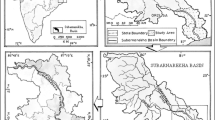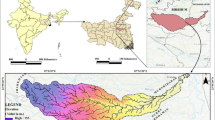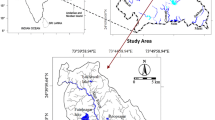Abstract
Soil conservation planning often requires estimates of the spatial distribution of soil erosion at a catchment or regional scale. This paper applied the Revised Universal Soil Loss Equation (RUSLE) to investigate the spatial distribution of annual soil loss over the upper basin of Miyun reservoir in China. Among the soil erosion factors, which are rainfall erosivity (R), soil erodibility (K), slope length (L), slope steepness (S), vegetation cover (C), and support practice factor (P), the vegetative cover or C factor, which represents the effects of vegetation canopy and ground covers in reducing soil loss, has been one of the most difficult to estimate over broad geographic areas. In this paper, the C factor was estimated based on back propagation neural network and the results were compared with the values measured in the field. The correlation coefficient (r) obtained was 0.929. Then the C factor and the other factors were used as the input to RUSLE model. By integrating the six factor maps in geographical information system (GIS) through pixel-based computing, the spatial distribution of soil loss over the upper basin of Miyun reservoir was obtained. The results showed that the annual average soil loss for the upper basin of Miyun reservoir was 9.86 t ha − 1 ya − 1 in 2005, and the area of 46.61 km2 (0.3%) experiences extremely severe erosion risk, which needs suitable conservation measures to be adopted on a priority basis. The spatial distribution of erosion risk classes was 66.9% very low, 21.89% low, 6.18% moderate, 2.89% severe, and 1.84% very severe. Thus, by using RUSLE in a GIS environment, the spatial distribution of water erosion can be obtained and the regions which susceptible to water erosion and need immediate soil conservation planning and application over the upper watershed of Miyun reservoir in China can be identified.
Similar content being viewed by others
References
Beasley, D. B., Huggins, L. F., & Monke, E. J. (1980). ANSWERS: A model for watershed planning. Transactions of the American Society of Agricultural Engineers, 23(4), 938–944.
Bu, Z. H., Tang, W. L., Yang, L. Z., Xi, C. F., Liu, F. X., Wu, J. Y., et al. (2003). The progress of quantitative remote sensing method for annual soil losses and its application in Taihu-Lake catchments. Acta Pedologica Sinica, 40(1), 1–9. (in Chinese).
Cartagena, D. F. (2004). Remotely sensed land cover parameter extraction for watershed erosion modeling. MSc. Thesis, International Institute for Geo-information Science and Earth Observation, Enschede, The Netherlands, ITC publications.
Chen, T., Li, P. X., & Zhang, L. P. (2008). Retrieving vegetation cover by using BP neural network based on “Beijing-1” microsatellite data. In The international conference on earth observation data processing and analysis (ICEODPA2008), 28–30 December 2008, China.
Chinese River Sediment Bulletin (2006). The ministry of water resources of the People’s Republic of China.
Chinese Soil Taxonomy Research Group, Institute of Soil Science, Academia Sinica and Cooperative Research Group on Chinese Soil Taxonomy (1995) Chinese soil taxonomy (revised proposal). Beijing: China Agricultural Science and Technology Press.
Cihlar, J. (1987). A methodology for mapping and monitoring cropland soil erosion. Canadian Journal of Soil Science, 67(3), 433–444.
De Jong, S. M. (1994). Derivation of vegetative variables from a Landsat TM image for modelling soil erosion. Earth Surface Processes and Landforms, 19(2), 165–178.
De Jong, S. M., Paracchini, M. L., Bertolo, F., Folving, S., Megier, J., & De Roo, A. P. J. (1999). Regional assessment of soil erosion using the distributed model SEMMED and remotely sensed data. Catena, 37(3–4), 291–308.
De Jong, S. M., & Riezebos, H. T. (1997). SEMMED: A distributed approach to soil erosion modelling. In A. Spiteri (Ed.), Remote sensing ’96: Integrated applications for risk assessment and disaster prevention for the Mediterranean (pp. 199–204). Rotterdam: Balkema.
Deore, S. J. (2005). Prioritization of micro-watersheds of upper Bhama Basin on the basis of soil erosion risk using remote sensing and GIS technology. Ph.D. Thesis, Department of Geography, University of Pune.
Dymond, J. R., Stephens, P. R., Newsome, P. F., et al. (2005). Percent vegetation cover of a degrading rangeland from SPOT. International Journal of Remote Sensing, 13(11), 1999–2007.
Folly, A., Bronsveld, M. C., & Clavaux, M. (1996). A knowledge-based approach for C-factor mapping in Spain using Landsat TM and GIS. International Journal of Remote Sensing, 17(12), 2401–2415.
Fu, B. J., Zhao, W. W., Chen, L. D., et al. (2005). Assessment of soil erosion at large watershed scale using RUSLE and GIS: A case study in the loess plateau of China. Land Degradation and Development, 16, 73–85.
Gao, J. R. (1999). Construction and countermeasures of water protection forest in Miyun reservoir watershed of Beijing City. Bull Soil Water Conservation, 19, 1–6.
Gertner, G., Wang, G., Fang, S., & Anderson, A. B. (2002). Mapping and uncertainty of predictions based on multiple primary variables from joint co-simulation with Landsat TM image and polynomial regression. Remote Sensing of Environment, 83(3), 498–510.
Graetz, R. D., Pech, R. R., & Davis, A. W. (1988). The assessment and monitoring of sparsely vegetated rangelands using calibrated Landsat data. International Journal of Remote Sensing, 9(7), 1201–1222.
Grepperud, S. (1995). Soil conservation and government policies in tropical area: Does aid worsen the incentives for arresting erosion. Agricultural Economics, 12, 120–140.
Hazarika, M. K., & Honda, K. (2001). Estimation of soil erosion using remote sensing and GIS: Its valuation and economic implications on agricultural production. In D. E. Stott, R. H. Mohtar, & G. C. Steinhardt (Eds.), Sustaining the global farm (pp. 1090–1093). Purdue University and USDA-ARS National Soil Erosion Research Laboratory.
Homik, K., Stinchcombe, M., & White, H. (1989). Multi-layer feed forward networks are universal approximators. Neural Networks, 2, 359–366.
Juergens, C., & Fander, M. (1993). Soil erosion assessment by means of Landsat-TM and ancillary digital data in relation to water quality. Soil Technology, 6(3), 215–223.
Lin, C. Y., Lin, W. T., & Chou, W. C. (2002). Soil erosion prediction and sediment yield estimation: The Taiwan experience. Soil and Tillage Research, 68(2), 143–152.
Lin, W. T., Lin, C. Y., & Chou, W. C. (2006). Assessment of vegetation recovery and soil erosion at landslides caused by a catastrophic earthquake: A case study in Central Taiwan. Ecological Engineering, 28(1), 79–89.
Liu, B. Y., Nearing, M. A., Shi, P. J., & Jia, Z. W. (2000). Slope length effects on soil loss for steep slopes. Soil Science Society of America Journal, 64, 1759–1763.
López-Vicente, M., & Navas, A. (2009). Predicting soil erosion with RUSLE in Mediterranean agricultural systems at catchment scale. Soil Science, 174(5), 272–282.
Lu, H., Prosser, I. P., Moran, C. J., Gallant, J. C., Priestly, G., & Stevenson, J. G. (2003). Predicting sheetwash and rill erosion over the Australian continent. Australian Journal of Soil Research, 41(6), 1037–1062.
Lufafa, A., Tenywa, M. M., Isabirye, M., Majaliwa, M. J. G., & Woomer, P. L. (2003). Prediction of soil erosion in a Lake Victoria basin catchment using a GIS-based universal soil loss model. Agricultural Systems, 76(3), 883–894.
Millward, A. A., & Mersey, J. E. (1999). Adapting the RUSLE to model soil erosion potential in a mountainous tropical watershed. Catena, 38(2), 109–129.
Morgan, R. P. C. (1995). Soil erosion and conservation (2nd ed.). Essex: Longman Group Limited.
Morgan, R. P. C., Morgan, D. D. V., & Finney, H. J. (1984). A predictive model for the assessment of soil erosion risk. Journal of Agricultural Engineering Research, 30(1), 245–253.
Najmoddini, N. (2003). Assessment of erosion and sediment yield processes using remote sensing and GIS: A case study in rose chai sub-catchment of Orumieh Basin, W. Azarbaijan. MSc. Thesis, International Institute for Geo-information Science and Earth Observation, Enschede, The Netherlands, ITC publications.
Nearing, M. A., Deer-Ascough, L., & Laflen, J. M. (1990). Sensitivity analysis of the WEPP hillslope profile erosion model. Transactions ASAE, 33(3), 839–849.
NSERL (1995). WEPP user summary. National Soil Erosion Research Laboratory, US Department of Agriculture. http://topsoil.nserl.purdue.edu/nserlweb/weppmain/docs/readme.htm. Accessed 30 March 2007.
Onori, F., Bonis, P. D., Grauso, S., et al. (2006). Soil erosion prediction at the basin scale using the revised universal soil loss equation (RUSLE) in a catchment of Sicily (southern Italy). Environment Geology, 50, 1129–1140.
Paningbatan, E. P. (2001). Geographic information system-assisted dynamic modeling of soil erosion and hydrologic processes at a watershed scale. Philippine Agricultural Scientist, 84(4), 388–393.
Purevdorj, T. S., Tateishi, R., Ishiyama, T., et al. (1998). Relationships between percent vegetation cover and vegetation indices. International Journal of Remote Sensing, 19(18), 3519–3535.
Renard, K. G., Foster, G. A., Weesies, G. A., & McCool, D. K. (1997). Predicting soil erosion by water: A guide to conservation planning with RUSLE. USDA. Agriculture Handbook No. 703. Washington, DC.
Stephens, P. R., & Cihlar, J. (1982). Mapping erosion in New Zealand and Canada. In C. J. Johannsen, & J. L. Sanders (Eds.), Remote sensing and resource management (pp. 232–242). Ankeny: Soil Conservation Society of America.
Symeonakis, E., & Drake, N. (2004). Monitoring desertification and land degradation over sub-Saharan Africa. International Journal of Remote Sensing, 25(3), 573–592.
Thampapillai, D. A., & Anderson, J. R. (1994). A review of the socio-economic analysis of soil degradation problem for developed and developing countries. Review of Marketing and Agricultural Econmics, 62, 291–315.
The Ministry of Water Resources of the People’s Republic of China (1997). National professional standards for classification and gradation of soil erosion, SL 190-1996.
Tweddales, S. C., Eschlaeger, C. R., & Seybold, W. F. (2000). An improved method for spatial extrapolation of vegetative cover estimates (USLE/RUSLE C factor) using LCTA and remotely sensed imagery. USAEC report No. SFIM-AEC-EQ-TR-200011, ERDC/CERL TR-00-7, US Army of Engineer Research and Development Center, CERL, Champaign, Illinois.
Van der Knijff, J., Jone, R. J. A., & Montanarella, L. (2002). Soil erosion risk assessment in Italy. European Soil Bureau, Joint Research Center of European Commission. EUR 19022EN.
Wang, G., Gertner, G., Fang, S., Anderson, A. B. (2003a). Mapping multiple variables for predicting soil loss by geostatistical methods with TM images and a slope map. Photogrammetric Engineering and Remote Sensing, 69(8), 889–898.
Wang, G., Gertner, G., Fang, S., et al. (2003b). Mapping multiple variables for predicting soil loss by geostatistical methods with TM images and a slope map. Photogrammetric Engineering and Remote Sensing, 69, 889–898.
Wang, G., Wente, S., Gertner, G. Z., & Anderson, A. (2002). Improvement in mapping vegetation cover factor for the universal soil loss equation by geostatistical methods with landsat thematic mapper images. International Journal of Remote Sensing, 23(18), 3649–3667.
Wischmeier, W. H., & Smith, D. D. (1978). Predicting rainfall erosion losses: A guide to conservation planning, USDA. Washington, DC: Agriculture Handbook No. 537.
Yang, D. Z., Xu, X. D., Liu, X. D., et al. (2005). Complex sources of air-soil-water pollution processes in the Miyun reservoir region. Science in China Series D Earth Sciences, 48(Supp. II), 230–245.
Yu, X. X., Niu, J. Z., & Xu, J. L. (2004). Effects of closing mountain for forest restoration in the watershed of Miyun reservoir Beijing. Forestry Studies in China, 6(3), 28–35.
Zhou, W. F., & Wu, B. F. (2005). Soil erosion estimation of the upriver areas of Miyun Reservoir located on the Chaobai River using remote sensing and GIS. Transactions of the CSAE, 21(10), 46–50.
Author information
Authors and Affiliations
Corresponding author
Rights and permissions
About this article
Cite this article
Chen, T., Niu, Rq., Wang, Y. et al. Assessment of spatial distribution of soil loss over the upper basin of Miyun reservoir in China based on RS and GIS techniques. Environ Monit Assess 179, 605–617 (2011). https://doi.org/10.1007/s10661-010-1766-z
Received:
Accepted:
Published:
Issue Date:
DOI: https://doi.org/10.1007/s10661-010-1766-z




